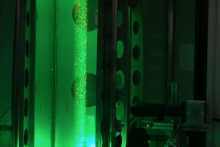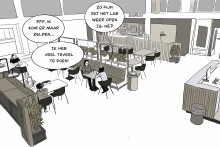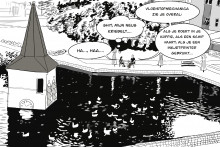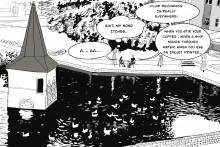PhD student Varghese Mathai and co-workers from the University of Twente have shown that scientists may have overlooked a simple force of nature: gravity. This may have a strong bearing on studies of climatic change and rain clouds.
Tracking particles
This week Varghese Mathai and his fellow researchers of the MESA+ institute of the University Twente will publish a remarkable article in the Physical Review Letters. For almost three years, Mathai worked on the science of fluid dynamics, in particular on the behavior of particles and air bubbles in water streams.
It has been widely believed by researchers that tiny particles and air bubbles will accurately follow a water flow. By observing these particles, once can trace the flow and currents in streaming water, which normally is invisible as water is clear. This technique of tracking particles is one of the core methods of experimental fluid dynamics.
Gravity
Now, Mathai and co-workers have put this decades old practice into question. They discovered that bubbles that are widely used to visualize the movements of the fluids, do not behave exactly as scientists have always thought.
During their experiments performed in the Twente Water Tunnel Facility (TWT), an eight-meter high turbulence laboratory machine, the researchers ran into some initial results that they couldn't explain. ‘We saw unmistakable deviations in the accelerations of the tiny bubbles and particles that we could not explain. Nor could the current scientific models that we use explain these little movements of the particles and bubbles’, says coauthor Chao Sun from Tsinghua University (also University of Twente). The researchers hypothesized that gravity could be the disturbing factor, and the gentle drift of tiny particles under the action of gravity could play a role in these deviations.
Rain
The researchers then undertook an extensive numerical study in collaboration with Enrico Calzavarini of University of Lille, which confirmed their experimental observations. They developed new theoretical models that predict this until-now unexpected behavior of the particles.
Today Mathai tells UT Nieuws: ‘These results have strong bearing, not only on everyday laboratory experiments, but also on the modeling of climatic processes and even on rain initiation in clouds.’
High-speed camera
The classical assumption, that a tiny particle or an air bubble exactly follows the flow, needs to be corrected, says professor Detlef Lohse. ‘Even tiny bubbles and particles have a tendency to drift through the flow. With the naked eye or even with modern laboratory facilities one may not notice this very small and slow drift behavior. We had to develop a special moving high-speed camera setup, which led to these revelations.’
The publication ‘Micro-bubbles and micro-particles are not faithful tracers of turbulent acceleration’, written by Varghese Mathai, Enrico Calzavarini, Jon Brons, Chao Sun and Detlef Lohse, will appear online in the July 8 issue of the Physical Review Letters journal.









